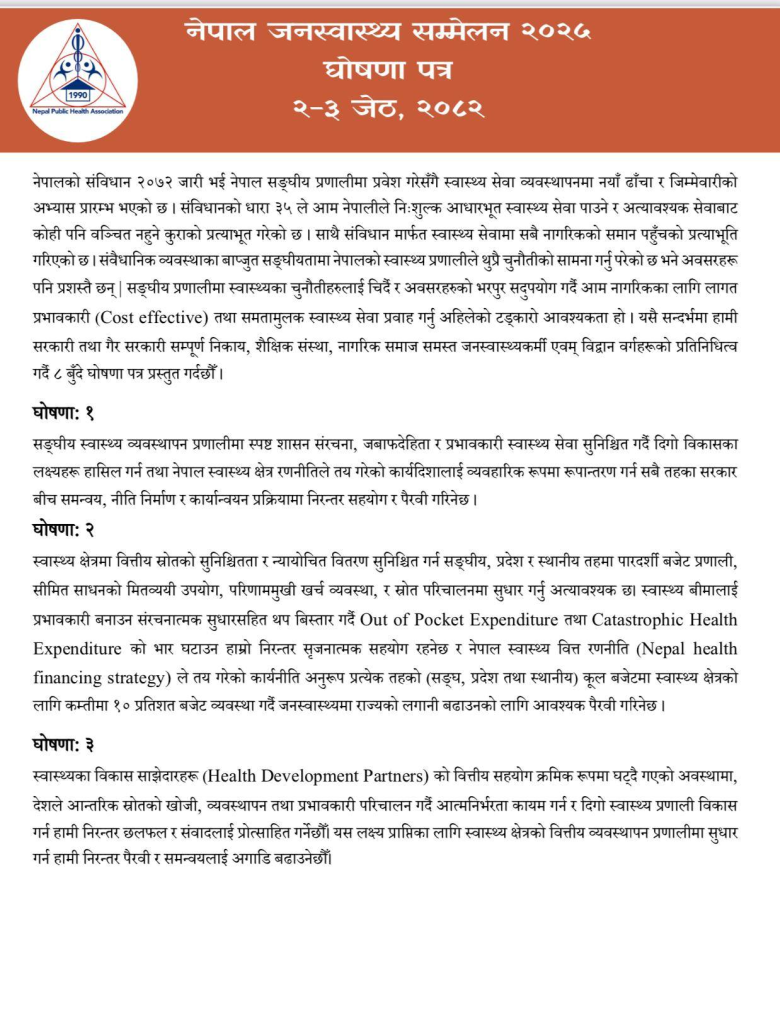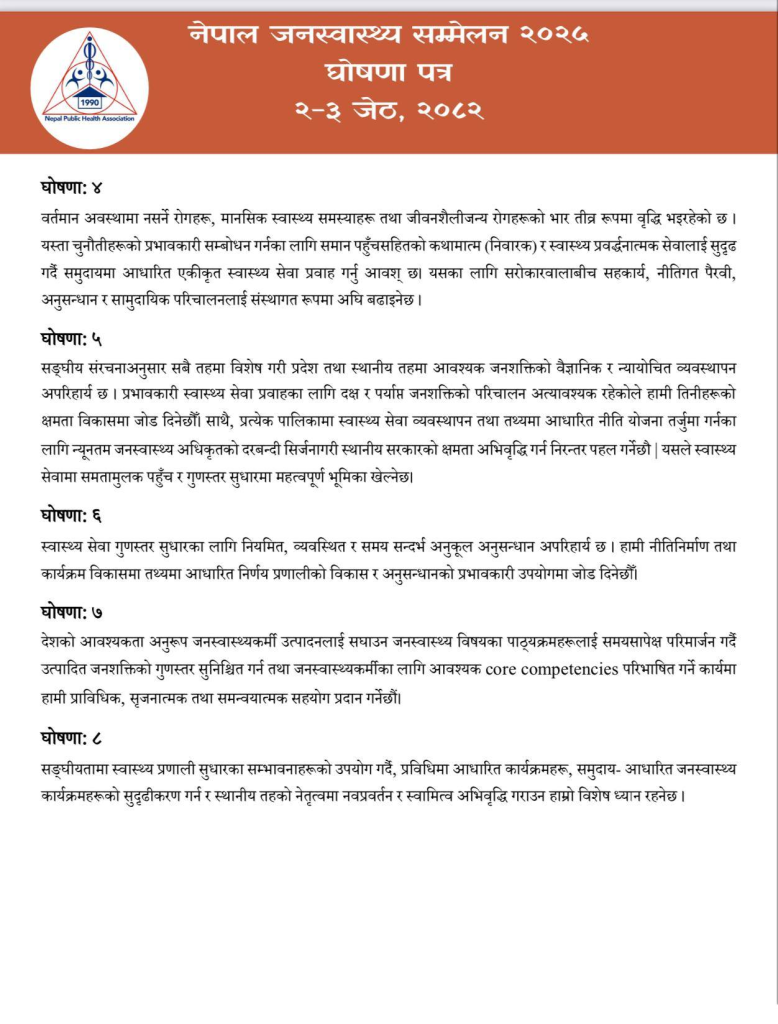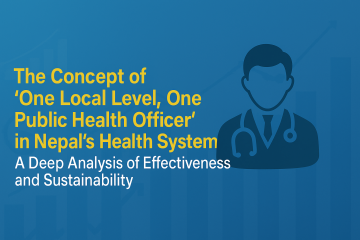Nepal has reached a historic milestone in its journey toward better health for all. The Nepal Public Health Association (NEPHA) recently organized the First Nepal Public Health Conference on Jestha 2–3, 2082 (May 16–17, 2025). It brought together experts, policymakers, and community leaders. The goal was to reimagine Nepal’s health system under federalism. This dynamic event focused on health sector reform and lessons from the COVID-19 era. It produced a landmark declaration of 10 commitments. These commitments will shape the nation’s public health agenda for years to come.
What Made This Conference Special?
- A National Platform: The conference convened leading public health minds, government officials, academics, and practitioners from across Nepal and beyond.
- Forward-Thinking Themes: Discussions focused on health system reform, federalism, COVID-19 lessons, health financing, quality of care, and emerging public health challenges46.
- Actionable Outcomes: The event concluded with a powerful declaration-10 key resolutions aimed at strengthening Nepal’s health system, ensuring equity, and promoting innovation.
The 10 Declarations: Nepal’s Roadmap for Public Health
1. Strengthening Federal Health Governance
- Commit to robust governance, coordination, and accountability at all government levels.
- Ensure accessible, effective, and accountable health services for every Nepali.
2. Equitable and Adequate Health Financing
- Allocate at least 10% of government budgets to health at all levels.
- Reduce out-of-pocket and catastrophic health expenditures.
- Implement effective financial strategies for universal health coverage.
3. Partnership with Health Development Partners
- Foster collaboration with domestic and international partners.
- Mobilize resources and expertise for a resilient, self-reliant health system.
4. Prioritizing Mental Health and NCDs
- Address the rising burden of mental health issues and non-communicable diseases.
- Promote community-based, data-driven interventions and policies.
5. Evidence-Based and Equitable Service Management
- Ensure scientific, equitable management of health services from local to federal levels.
- Prioritize quality, accessibility, and efficiency in all health programs.
6. Quality Assurance and Standards
- Develop and enforce national standards for health service quality.
- Regularly monitor, evaluate, and improve health programs.
7. Public Health Workforce Development
- Define core competencies and provide continuous training for public health professionals.
- Support and empower the health workforce for evolving national needs.
8. Innovation in Surveillance and Leadership
- Strengthen health surveillance and promote evidence-based programming.
- Encourage local leadership and innovation in public health.
9. Inclusive and Participatory Health Services
- Engage communities in planning, implementing, and monitoring health services.
- Ensure health services are people-centered and inclusive.
10. Continuous Review and Accountability
- Commit to regular assessment, transparent reporting, and responsive improvement of the health system.
Why Do These Declarations Matter?
These commitments are more than words-they are a blueprint for action. Nepal is focusing on governance, financing, partnership, workforce, innovation, and community engagement. This focus is setting the stage for a resilient, inclusive, and modern health system.
Interactive: What’s Next for Nepal’s Health?
- For Health Workers: Expect more training, support, and recognition.
- For Policymakers: Prepare for stronger collaboration, data-driven decisions, and increased accountability.
- For Communities: Your voice matters-get involved in shaping local health priorities!
[Full Declaration Text (Unofficial English Translation)]
Declaration 1:
Strengthen federal health governance, coordination, and accountability for accessible, quality health services nationwide.
Declaration 2:
Ensure equitable and adequate health financing. Allocate at least 10% of budgets to health. Reduce out-of-pocket expenses. Implement effective financing strategies.
Declaration 3:
Enhance collaboration with Health Development Partners for resource mobilization and system strengthening.
Declaration 4:
Prioritize mental health and non-communicable diseases with community-based, evidence-driven interventions.
Declaration 5:
Manage health services scientifically and equitably at all levels, prioritizing quality and accessibility.
Declaration 6:
Develop and enforce quality standards for health services, with regular monitoring and improvement.
Declaration 7:
Define core competencies and support continuous development of the public health workforce.
Declaration 8:
Promote innovation in health surveillance, evidence-based programs, and local leadership.
Declaration 9:
Ensure inclusive, participatory health services with active community engagement.
Declaration 10:
Commit to ongoing review, transparent reporting, and continuous health system improvement.
Official Decleration Doc


Stay tuned to www.phcnepal.com for in-depth stories and updates as Nepal turns these bold declarations into reality!
Let’s build a healthier Nepal-together!
Discover more from Public Health Concern Nepal
Subscribe to get the latest posts sent to your email.










